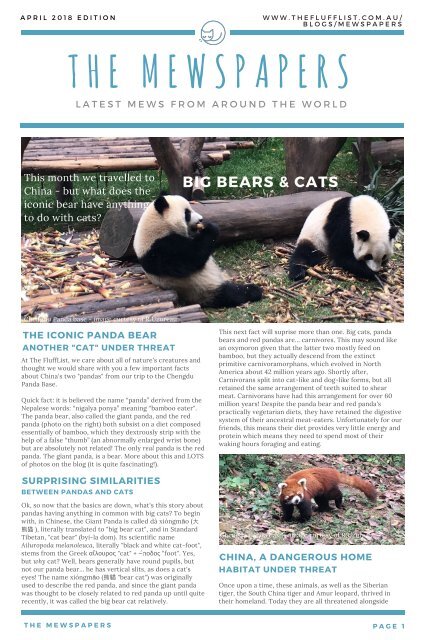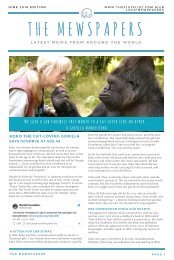The Mewspapers - APRIL 2018
Find out what the FluffList's traveller Roxane has discovered about the big bear cats in China earlier this month, the latest tech for cats, cool facts and more!
Find out what the FluffList's traveller Roxane has discovered about the big bear cats in China earlier this month, the latest tech for cats, cool facts and more!
You also want an ePaper? Increase the reach of your titles
YUMPU automatically turns print PDFs into web optimized ePapers that Google loves.
P R I L 2 0 1 8 E D I T I O N W W W . T H E F L U F F L I S T . C O M . A U /<br />
A<br />
L O G S / M E W S P A P E R S<br />
B<br />
T H E M E W S P A P E R S P A G E 1<br />
T H E M E W S P A P E R S<br />
L A T E S T M E W S F R O M A R O U N D T H E W O R L D<br />
This month we travelled to<br />
China - but what does the<br />
iconic bear have anything<br />
to do with cats?<br />
BIG BEARS & CATS<br />
Chengdu Panda base - image curtesy of R.Uzureau<br />
THE ICONIC PANDA BEAR<br />
ANOTHER "CAT" UNDER THREAT<br />
At <strong>The</strong> FluffList, we care about all of nature's creatures and<br />
thought we would share with you a few important facts<br />
about China's two "pandas" from our trip to the Chengdu<br />
Panda Base.<br />
Quick fact: it is believed the name “panda” derived from the<br />
Nepalese words: “nigalya ponya” meaning “bamboo eater".<br />
<strong>The</strong> panda bear, also called the giant panda, and the red<br />
panda (photo on the right) both subsist on a diet composed<br />
essentially of bamboo, which they dextrously strip with the<br />
help of a false “thumb” (an abnormally enlarged wrist bone)<br />
but are absolutely not related! <strong>The</strong> only real panda is the red<br />
panda. <strong>The</strong> giant panda, is a bear. More about this and LOTS<br />
of photos on the blog (it is quite fascinating!).<br />
This next fact will suprise more than one. Big cats, panda<br />
bears and red pandas are... carnivores. This may sound like<br />
an oxymoron given that the latter two mostly feed on<br />
bamboo, but they actually descend from the extinct<br />
primitive carnivoramorphans, which evolved in North<br />
America about 42 million years ago. Shortly after,<br />
Carnivorans split into cat-like and dog-like forms, but all<br />
retained the same arrangement of teeth suited to shear<br />
meat. Carnivorans have had this arrangement for over 60<br />
million years! Despite the panda bear and red panda's<br />
practically vegetarian diets, they have retained the digestive<br />
system of their ancestral meat-eaters. Unfortunately for our<br />
friends, this means their diet provides very little energy and<br />
protein which means they need to spend most of their<br />
waking hours foraging and eating.<br />
SURPRISING SIMILARITIES<br />
BETWEEN PANDAS AND CATS<br />
Ok, so now that the basics are down, what's this story about<br />
pandas having anything in common with big cats? To begin<br />
with, in Chinese, the Giant Panda is called dà xióngmāo (⼤<br />
熊 猫 ), literally translated to "big bear cat", and in Standard<br />
Tibetan, "cat bear" (byi-la dom). Its scientific name<br />
Ailuropoda melanoleuca, literally "black and white cat-foot",<br />
stems from the Greek αἴλουρος "cat" + ‒́ποδος "foot". Yes,<br />
but why cat? Well, bears generally have round pupils, but<br />
not our panda bear... he has vertical slits, as does a cat's<br />
eyes! <strong>The</strong> name xióngmāo ( 熊 貓 "bear cat") was originally<br />
used to describe the red panda, and since the giant panda<br />
was thought to be closely related to red panda up until quite<br />
recently, it was called the big bear cat relatively.<br />
Chengdu Panda base - image curtesy of R.Uzureau<br />
CHINA, A DANGEROUS HOME<br />
HABITAT UNDER THREAT<br />
Once upon a time, these animals, as well as the Siberian<br />
tiger, the South China tiger and Amur leopard, thrived in<br />
their homeland. Today they are all threatened alongside
T H E M E W S P A P E R S P A G E 2<br />
over 385 other species in China alone.<br />
Once widespread throughout southern<br />
and eastern China, as well as Myanmar<br />
and northern Vietnam, the giant panda<br />
is now restricted to around 20 isolated<br />
patches of bamboo forest in six<br />
mountain ranges in China's Sichuan,<br />
Shaanxi and Gansu provinces, with most<br />
of the remaining wild pandas living<br />
in the Minshan and Qinling mountains.<br />
Efforts to save the pandas have been<br />
long and difficult but finally bore fruit<br />
when in 2016 the species downgraded<br />
from ‘Endangered’ to ‘Vulnerable’ on the<br />
global list of species risking extinction.<br />
With a network of 67 panda reserves<br />
that safeguard over 66% of the giant<br />
pandas in the wild and almost 54% of<br />
their current habitat, and protected<br />
migration corridors to encourage them<br />
to travel safely in search of mates and<br />
food, the recovery is slow but hopeful.<br />
B E A R S STILL AT RISK<br />
R E D PANDAS LOSING HOMES<br />
But what about those less iconic<br />
animals? Habitat loss is also a cause for<br />
the decreasing population of red<br />
pandas, of which 50 percent live in the<br />
Eastern Himalayas. In communities<br />
bordering red panda habitat, most<br />
households rely on the forest for<br />
firewood for cooking fuel, harvest it for<br />
medicinal plants, often overexploited<br />
and traded illegally. <strong>The</strong>y are also<br />
poached for their distinctive pelts in<br />
China and Myanmar, and red panda fur<br />
caps or hats have been found for sale in<br />
Bhutan. A lot has yet to be done for the<br />
red panda.<br />
tigersincrisis.com<br />
image curtesy of R.Uzureau<br />
DISAPPEARING BIG CATS<br />
Finally, our big cats. In the past century,<br />
the world lost over 90% of its tiger<br />
population; in China, there are only<br />
about 90 tigers left in the wild. Siberian<br />
tigers, also called the Amur tigers, are<br />
only an estimated 350-450 individuals in<br />
the wild. Almost all live the Southeast<br />
corner of Russia in the Sikhote-Alin<br />
mountain range east of the Amur River,<br />
but used to roam northeastern China<br />
and the Korean Peninsula, and as far<br />
west as Mongolia. Poaching and habitat<br />
loss from intensive logging and<br />
development are the first cause of their<br />
decline.<br />
<strong>The</strong> South China tiger, also known as<br />
the Chinese, Amoy or Xiamen Tiger,<br />
used to roam the temperate forests of<br />
southeast China. <strong>The</strong> smallest of all the<br />
tiger subspecies, some believe it is<br />
"practically extinct" for the reality is<br />
that none have been seen in the wild for<br />
the last 20 years. <strong>The</strong>ir decline was<br />
shockingly fast; in the 1970’s, it was<br />
estimated there were over 4,000 South<br />
China tigers in the wild. Considered<br />
‘pests’ by the Chinese government, they<br />
were hunted to their current status of<br />
being on the brink of extinction.<br />
THIS ALARMING RATE OF<br />
EXTINCTION IS 100-1,000 TIMES,<br />
AND PERHAPS EVEN 11,000<br />
TIMES, GREATER THAN THE<br />
EXPECTED NATURAL RATE.<br />
ONE IN FOUR OF THE WORLD’S<br />
MAMMALS ARE NOW<br />
THREATENED WITH EXTINCTION<br />
IN THE NEAR FUTURE.<br />
— WWF.PANDA.ORG<br />
worldwildlife.org<br />
Critically endangered, the Amur leopard<br />
once lived throughout northeastern<br />
China and the Korean Peninsula. Also<br />
known as the Far East leopard, the<br />
Manchurian leopard or the Korean<br />
leopard, this big cat's habitat in Russia<br />
was dramatically reduced during the<br />
seventies, losing about 80% of its<br />
former range. <strong>The</strong> most recent results<br />
from population monitoring in 2011<br />
suggests there are now approximately<br />
40 individuals in Russia, and surveys<br />
carried out in China in 2012 estimate<br />
fewer than 20 leopards.<strong>The</strong> Amur<br />
leopard probably went extinct in the<br />
wild in South Korea in the late 1960s, as<br />
the last sighting dates back to 1969.<br />
We hope to have enlightened you on<br />
some of Asia's most endangered species,<br />
and hope that together we will bring<br />
back what we have taken away.<br />
CAT BOOK OF THE<br />
MONTH:<br />
A CAT CALLED PANDA<br />
We're a little partial when it comes to<br />
this illustrated children's book, since<br />
the main character, a bicolor moggie, is<br />
named after China's most iconic bear...<br />
for the same reason as was Roxane's<br />
first black and white cat: Panda.<br />
Featuring original hand-printed<br />
artwork, children follow Amanda and<br />
Panda and engage in the story to find<br />
the black and white hidden animals on<br />
the pages. Brought to life with<br />
contrasting splashes of colour, this<br />
whimsical nonsense-style poem was<br />
inspired by author and illustrator<br />
Melanie Arora's cat named Panda.<br />
Born in 1977 to an Indian father and<br />
English mother in North London.<br />
Inspired as a child by famous children's<br />
books such as <strong>The</strong> Cat in the Hat, she<br />
has always loved playing with words<br />
and has a well developed sense of the<br />
ridiculous. This is her delightful first<br />
book<br />
RARE CAT ON CAMERA:<br />
THE SCOTTISH WILDCAT<br />
If you thought Scotland's only mythical<br />
creature lived in the Loch Ness, think<br />
again, and meet another highly elusive<br />
and unique creature: the Highlands<br />
tiger. No, he's not a big cat (have you<br />
seen a tiger taking a bath with<br />
Nessie?), but is recognised as a valid<br />
subspecies of the wildcat by<br />
the Integrated Taxonomic Information<br />
System. <strong>The</strong> Felis silvestris grampia,<br />
whose subspecies name grampia likely<br />
coming from the Grampian Mountains,<br />
a Scottish mountain range, used to<br />
roam across Northern England, Wales,<br />
and Southern Scotland.<br />
Believed to have been present in Britain<br />
since as far back as early Holocene,<br />
when the British Isles were connected
T H E M E W S P A P E R S P A G E 3<br />
to continental Europe via the<br />
Doggerland, over the last 150 years he<br />
has been so frequently killed to protect<br />
game species that it is believed there<br />
are as few as 100 left in the wild, and<br />
quite possibly less that have not had<br />
their genes diluted through interaction<br />
with domestic cats.<br />
It is the only wild feline left on the<br />
island of Great Britain.<br />
wikipedia<br />
So it was quite a fantastic event for<br />
Wildcat Haven who caught the cat on<br />
camera in Aberdeenshire's<br />
Clashindarroch Forest! Wildcat Haven is<br />
a Scottish conservation project which<br />
uses camera-traps to discreetly obtain<br />
footage of the animals, luring them with<br />
bait to the lens. From the video they<br />
assessed the "Clashindarroch Beast" on<br />
film to measure 1,2 metres from nose to<br />
tail!<br />
in 1919 and is still one of the most easily<br />
recognized cartoon characters out<br />
there. With his wide smile and big eyes,<br />
this kitty “spoke” with his expressions<br />
during the silent film era.<br />
This isn't Felix, but another charming<br />
black and white furbaby, Albie. Albie is a<br />
British Shorthair, and reportedly the<br />
master of his house in Sydney, Australia.<br />
According to his birthday (born 15-10-<br />
2017), this purbaby is very social, usually<br />
cooperative, but dislikes confrontations<br />
and can carry a bit of a grudge.. but<br />
never for very long. He likes harmony<br />
and sharing with others (on his own<br />
terms), as well as spending time<br />
outdoors, especially on the patio deck<br />
chairs. He greatly dislikes violence,<br />
injustice and conformity (luckily he has<br />
a very non-conformist coat!).<br />
Albie is a great follower of our<br />
@theflufflistcats account and we look<br />
forwards to publishing more facts for<br />
him to star in! You can check him out<br />
under his name @a_is_for_albie to see<br />
what he gets up to.<br />
BEST OF CAT TECH:<br />
VR FOR CATS<br />
ADVANCES IN TECHNOLOGY<br />
SHOULD NOT BE LIMITED TO<br />
HUMANKIND.<br />
- SARAH TISDALE<br />
Wildlife campaign, in partnership with<br />
RSPCA Victoria, the headsets are<br />
expected to be retailed around AU$370<br />
each, with a special edition for flat<br />
faces, and predicted to be in test sold<br />
across veterinary clinics in the States of<br />
Victoria and New South Wales as early<br />
as June this year.<br />
FEATURE PRODUCT:<br />
KITTY COOKIE CUTTERS<br />
Wilcat Haven's efforts to save the<br />
species from extinction, now mostly<br />
caused by hybridisation with domestic<br />
cats. include successfully neutering<br />
domestic cats across the West<br />
Highlands.<br />
CAT FLUFF_FACTS:<br />
BLACK & WHITE & FAMOUS<br />
From black and white bears to bicolor<br />
cats, we thought we'd keep with the<br />
monochromatic theme!<br />
Felix the cat starred in his own cartoon<br />
Do you have an indoor cat? Worldwide,<br />
cat owners are choosing to housekeep<br />
their cats in order to protect them from<br />
the outdoors... and to protect the<br />
wildlife from them. But what if we could<br />
bring the great adventures of the<br />
outdoors inside our homes?<br />
Such was the challenge taken on by<br />
Zoos Victoria, Australia, to adapt an<br />
already existing technology for our cats,<br />
in a bid to enable them to experience<br />
the wild from the safety of their homes.<br />
<strong>The</strong> Cat VR headsets are every cat’s<br />
fantasy — the ball of yarn bears no end,<br />
cucumbers are grown farther than the<br />
horizon can tell, and cities are built of<br />
cardboard boxes.<br />
A part of Zoos Victoria’s Safe Cat, Safe<br />
We found these on Etsy, and, although<br />
we aren't the best cooks, we would<br />
almost want to get them just to wish<br />
these adorable cats onto our plates.<br />
Got a friend who loves to bake and<br />
loves cats? Possibly this is a win-win<br />
gift, as long as you leave a card with a<br />
suggestion that you'll be inviting<br />
yourself over for tea - what's a better<br />
biscuit than one (or two) enjoyed with a<br />
cuppa?<br />
Find these in cherryyee 's Etsy shop.<br />
Well that's it from us! We hope you<br />
enjoyed your April edition! Want to be<br />
featured in our fluff_facts? Get in<br />
touch, and get noticed on our IG<br />
account @theflufflistcats. Want to share<br />
a great product? Email us at<br />
theflufflisthq@gmail.com.<br />
Lots of purrs,<br />
Post-meowtum: we hope you guessed it<br />
already... "Best of cat tech: VR for cats"<br />
was the April Fool's spoof of the month!







